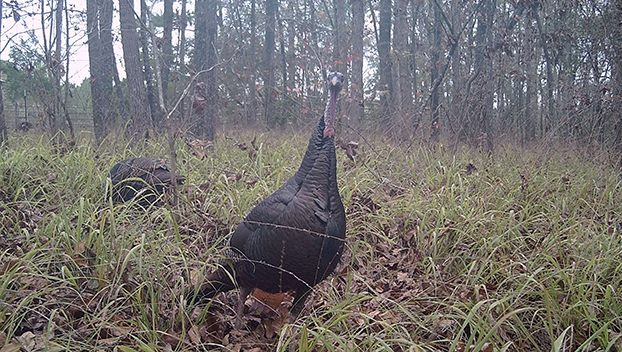Turkeys shifting to vital habitat
Published 1:15 pm Sunday, October 6, 2024

- A pair of gobblers walk on top of a ridge where mature mast producing trees are in a mixed pine forest. (The Daily Leader)
LOYD STAR — Mississippi’s 2025 spring turkey season is less than 165 days away, 161 days to be exact. Those who have succumbed to the addiction of hearing spring thunder can appreciate the start of a different stage in the turkey’s life history.
September marks a shift for turkeys into their fall and winter habitats. Soft and hard mast replaces the once abundant insects, seeds and leafy vegetative growth as the predominant food source. It is critical for habitat managers, landowners and hunters to promote diverse mixed forests to meet the needs of turkeys.
According to the Mississippi Department of Wildlife, Fisheries and Parks, turkeys begin to reduce the use of open habitats starting in September and increase the use of hardwoods and mature forests in October. Turkeys will shift their home ranges by several miles. MDWFP Turkey Program Director Adam Butler said it highlights why landowners should try to connect different habitat needs on their property.
Trending
“Keeping hardwoods and streamside management zones is important. The main thing is to make sure you don’t clear cut them,” Butler said.
He added MDWFP is working to launch a new pilot program aimed at restoring hardwood habitat in river bottoms and drainages by fighting invasive privet species. The program would help grow and expand river corridors which would otherwise be great habitat for turkeys if privet was not choking out the understory.
“That is a big deal. A lot of acres that would be good habitat are lost to privet,” Butler said. “They don’t have good space for turkeys and mast crops.”
Key to turkey success
By early November, turkeys spend almost all of their time in mature forests until late February. Butler wrote an article covering the fall season in a turkey’s life history. He stated turkeys eat wild grapes, black cherries, dogwood, pawpaw, and American beautyberry into October while soft mast is available.
Acorns and other hard masts such as hickory nuts, pecans, walnuts and beechnuts become a valuable food source from November until spring green-up. Turkeys will also eat pineseed. Anyone who has planted a food plot late in the fall knows turkeys love to scratch up seeds.
Trending
Acorns and other mast food sources are a high carbohydrate food source which also allows turkeys to build a fat reserve going into the spring breeding season.
“If you think about it, turkeys come out of winter in their best physiological shape. They are at their heaviest in the later part of the winter after they have been packing on acorns,” Butler said. “That is important because it plays a role in the reproductive cycle. Hens may nest later or may not nest at all if they don’t have a good winter which means lower reproductive success.”
Reproductive output is the name of the game for wild turkey populations. Availability of hardwood mast plays a part in maximizing reproductive output. Habitat managers and turkey hunters who work to increase turkey reproductive success should not only work on improving brood rearing and nesting cover but the health of mature hardwoods.
Segregated flocks
Turkeys begin to form flocks segregated by sex in the fall as well. Female offspring stay with their mother for their first fall and winter according to MDWFP. Male offspring will stay with their mother for the first part of their first fall and then break off to form their own flocks, MDWFP reports.
MDWFP states studies found hens and gobblers tend to use vastly different habitat types in the fall and winter. Hens tend to utilize bottomland hardwoods while gobblers utilize mixed pine and hardwood stands.
“We don’t necessarily know why that is. The general consensus is it allows them to exploit different food resources. Hens will be heavily focused on hardwoods and acorns in bottoms and along rivers. All turkeys use those areas very heavily,” Butler said. “One of the ideas about why Gobblers use mixed pine settings is because they are bigger, stronger and not as susceptible to predation. They are able to exploit more resources. There is also a little bit of hierarchy between flocks and in flocks. The flocks may not get along.”
Land use change
Butler said bottomland hardwoods are holding their own in terms of acreage. One area he is concerned about is the abundance of hardwoods in mixed pine settings where again gobblers like to spend their fall and winter.
According to the MDWFP Turkey Management Plan, Forested acres improved from 16.7 million acres in 1977 to 19.3 million acres in 2013 where the acres have remained steady. Loblolly pine forests have generally driven the increase in forested acres with a 3.1 million acre increase from 1977 to 2013. Oak and Pine mixed forests have declined since 1977 with a sharp decrease from 1994 to 2006. Oak and hickory mixed forests increased from 1977 to 1987 but have since decreased in acreage.
Pine plantation acreage increased six fold since 1977 while natural timber stands decreased. As of 2013, Oak and Pine acreage in Mississippi totaled 2,020,588 million acres. Loblolly pines totaled 7,333,903 acres in 2013.
Dwindling mixed pines
At the region level, southwest Mississippi has seen similar trends with loblolly pine forests dominating the landscape and mixed oak and pine stands declining since 1977.
According to the turkey management plan, recent studies from Mississippi State have shown that turkeys are most numerous in areas where hardwoods comprise one-third of the landscape and interspersion of other habitats is high. According to the United States Census Bureau, Lincoln County is 375,168 acres in size and would thus need 125,056 acres of hardwoods.
A majority of hardwoods in Lincoln County are found in mixed pine forests. .
“We have lost a lot of acres in Mississippi which would have been mixed pines. It jumps out at you the amount that has changed,” Butler said. “These mixed stands would have had southern red oak, water oak and post oak. A lot of mast producing type trees. The data is clear, a lot of acres have been converted into pine plantations. As hardwood acres dwindle, the remaining hardwoods are important. Be mindful, do your best to clean them up. Get rid of privet and whatever else chokes out the midstory.”
Early fall is a great time for landowners to plan out prescribed burning. There are generally three windows for prescribed fire with different impacts on the vegetative communities and plant response. Dormant season, early growing season and late growing season fires all can make an impact on habitat for turkeys.
Butler said this could also be a good time to mow some early successional areas and to think about food plots for deer and turkeys.
Anyone interested in managing a property for turkeys should request a site visit with the Private Lands Program at MDWFP.com. Biologists help people come up with a plan to meet their objectives for a property. Site visits are also great for gaining new insights to your property.





